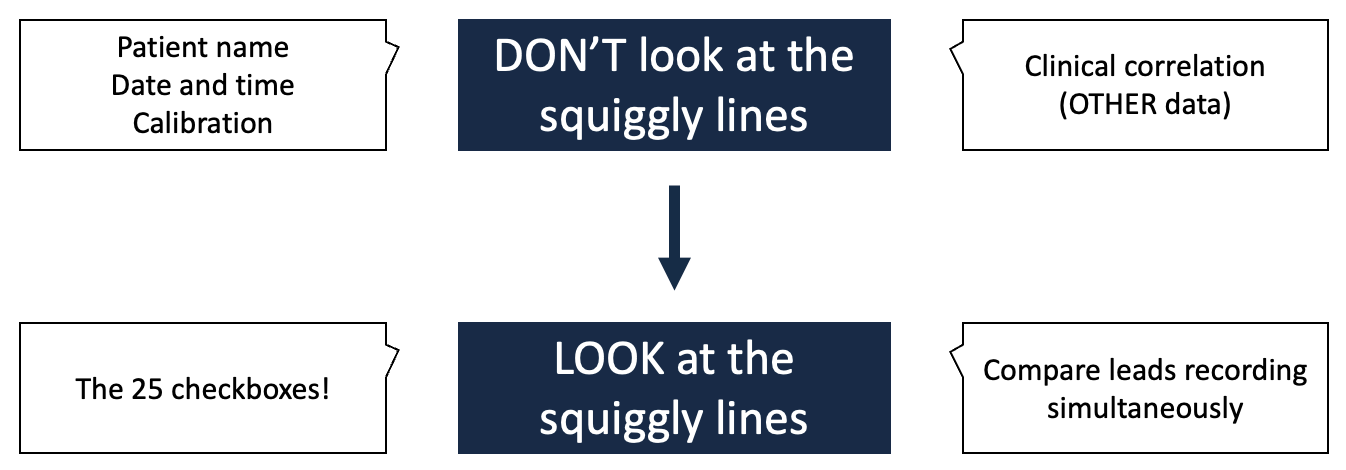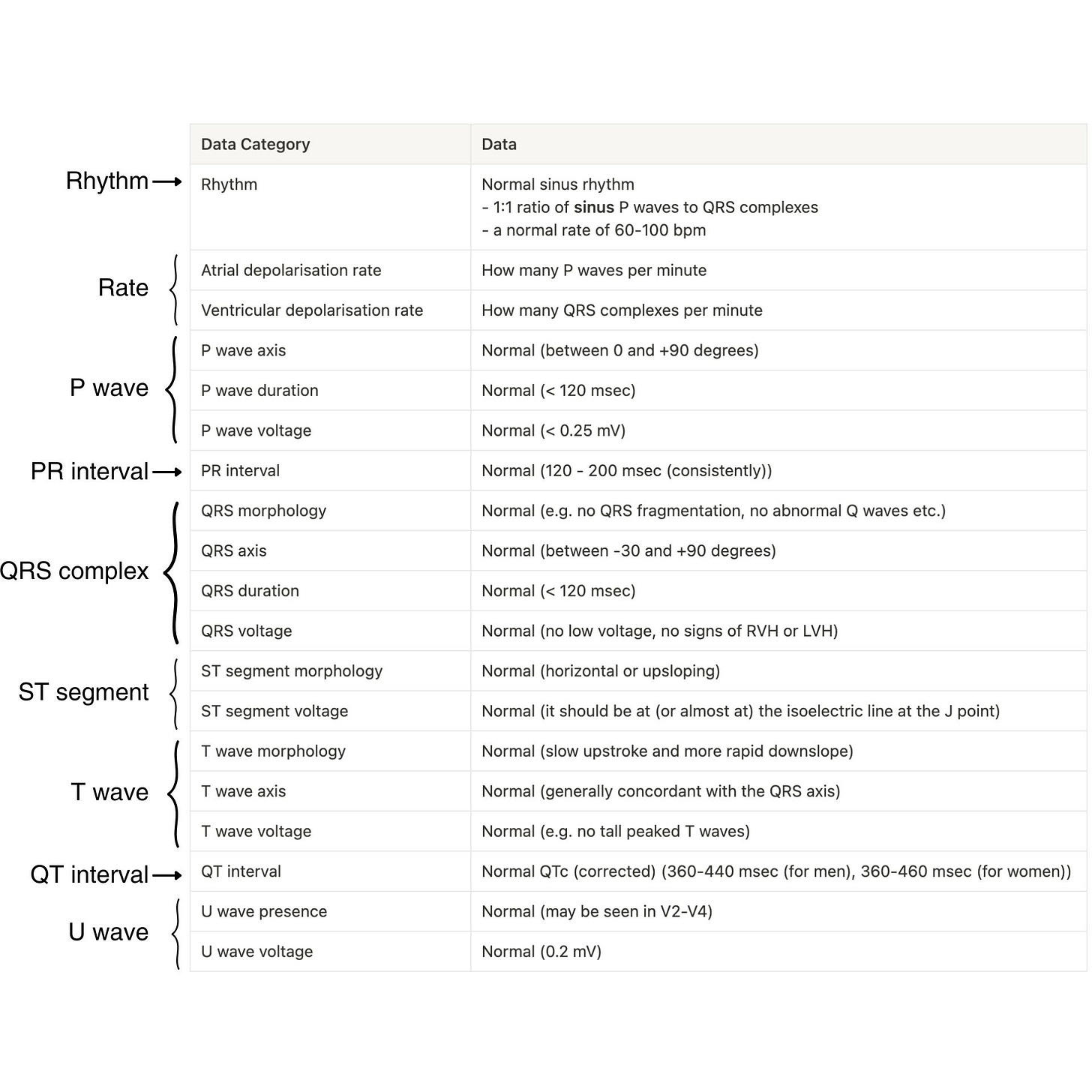The systematic approach to ECG interpretation
Find your method and become confident in ECGs once and for all!

Your method is the key to effective ECG interpretation
After interpreting thousands of ECGs and delivering hundreds of hours of ECG-related teaching, I have come to realise a fundamental fact:
You can identify most ECG-related problems only with basic ECG knowledge. Effective ECG interpretation is based primarily on your method, not your knowledge.
The key point of this article is that, by being methodical, you can drastically and immediately improve your ECG interpretation skills. In the meantime, you will start building solid ECG knowledge.
Start by thinking slow
“Thinking, Fast and Slow” (by Daniel Kahneman) is a lifechanging book I read a few years back. Why lifechanging? Because it clearly points out the mistakes in human judgement. The errors that I was making daily and the mistakes that I saw others make, especially those more senior and experienced than me.
In short, the book says that we have two modes of thinking: the fast and the slow.
The Fast (Type 1) mode of thinking is a quick and intuitive way of making decisions, often relying on heuristics and biases rather than deep analysis.
It’s the autopilot mode.
The Slow (Type 2) mode of thinking, on the other hand, is the one that requires deliberation and attention. It is the mode of thinking that allows us to weigh evidence, consider multiple possibilities, and arrive at a sound conclusion.
It’s the intentional mode.
What are heuristics?
Heuristics are mental shortcuts that help us make quick decisions by relying on our past experiences and assumptions.
For example, imagine you attempt to cross the road when your eyes catch a car coming with no intention to slow down. Before you can think (Type 2), you take a step back (quick decision as a result of Type 1 thinking). Essentially, your brain went, “OMG, we’re going to DIE today, do something quickly!” but all that happened subconsciously; there was no mental effort, it was based on heuristics, and a quick decision was made based on Type 1 thinking.
But when it comes to ECG interpretation (any medical data interpretation, really), you want to minimise the effect that your heuristics and biases will have on your decision-making. To do this, you have to start by “Thinking Slow”.
When I was younger, I wanted to learn how to play the guitar. My guitar teacher spent a considerable amount of time teaching me how to hold the guitar properly before even starting to play. At the time, I thought this was a complete waste of time. He used to say that if I didn't learn how to hold the guitar properly, I would struggle to play for life. And he was right.
At the start of your learning journey, you need to spend a considerable amount of time making a conscious effort.
This is how you can ensure that you will develop reliable heuristics. Then, in the future, when you practice your skill without making any conscious mental effort on the basics, you will at least know that you're practising the basics right.
And this 100% applies to ECG interpretation.
What am I looking at?
So you’re asked to review an ECG. What do you do exactly? This is what I would do:
DON’T look at the squiggly lines (yet)
Is this the correct ECG?
Check the patient’s name
Check the date and time of the recording
Has this ECG been recorded correctly?
Check the calibration; typically, it should be as follows:
Speed: 25 mm/s (this means that the paper is moving with a speed of 25 mm/s during the ECG recording) → this will produce the correct time-related data (e.g. 40 msec corresponding to 1 mm of ECG paper length)
Voltage (in both limb and precordial leads): 10 mm/mV (this means that 1 mm in ECG paper height corresponds to 0.1 mV)
Clinical correlation (OTHER, non-ECG-related data)
Why was this ECG done? What symptoms, signs, lab results etc. (i.e. OTHER, non-ECG-related data) did the patient present with to warrant an ECG to be done?
Check out this article for more explanation on this (The 2 Questions You Must Answer when Looking at an ECG)
NOW look at the squiggly lines
Check the 25 checkboxes! (see below)
While interpreting the ECG, always compare the leads that record simultaneously
The 25 checkboxes
There’s absolutely no need to learn them; just take a screenshot and use them EVERY time you interpret an ECG until this method becomes second nature.
There is nothing unique or magical about this method; it’s just the sequence of ECG data collection that I have been used to. I start with the rhythm and then collect all the ECG data from left to right (from the P wave to the QRS complex, to the T wave, and all the intervals and segments in between).
My suggestion would be to have this picture easily accessible and use it EVERY time you interpret an ECG.
As you go through the checkboxes one by one, feel free to search for your answers. For example, you reach the QRS complex > voltage box but don’t remember what the normal voltage is or what low voltage, LVH, or RVH should look like. Don’t worry! Google it!
Take your time; remember, you are building solid foundations!
Conclusion
Start by "Thinking Slow" and developing a reliable method for approaching ECG interpretation. After sufficient practice, this deliberate, slow approach will become second nature to you. As a result, you will interpret ECGs more quickly, and their interpretation will require less mental effort. However, always be aware of any false biases affecting your judgment.



